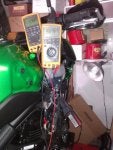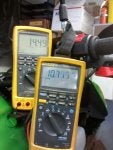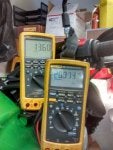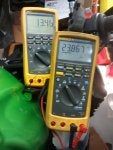Stator Testing / Loading/ Polaris 4012941&4016868 Discussion Thread
Stator Output 24 amp @ 14 VDC = 336 Watts
Note: December 2016**changed the values of VDC from 14.5 to 14.2 VDC This will cause the calculations done previously to be off, from what is posted***Typical shunt regulator puts out 14.5 to 15 VDC ( malfunctioning shunt regulators have caused ECU failure in the past, due to the fact they only start working / shunting @ or above 14.5 VDC, Series regulator is solid @ 14.2 VDC )
Noted 2019 ;
Be aware if reducing loads by converting to LED, do this only if you have converted to a Series Regulator. The Versys has sufficient power to run heated grips and heated gear for a total of about 150 Watts. Expect to be discharging the battery when below 2500 RPM if running this gear.Reducing base loads on the shunt regulator, primarily converting to LED headlight and LED city lights , could cause shunt regulator failure
I am going to start by saying, I found some startling news as to the Osram 65 Watt bulb I am using, and may be going back to OEM for low beam.
To simplify and reduce text :
Base load=ignition;fuel pump; tail and license plate bulbs; (city lights are LED)= 5.89 ADC @ 14.2 VDC
Headlight = Osram super bright PX26D #64217 rated 65 Watt @ 12VDC, actual wattage @ 14.2 VDC=80 Watts BTW they are now obsolete 5.3 ADC @ 14.2 VDC
Base Load Total including headlight = 162 watts on my 2015
Add approximately 10 Watts if using incandescent city lights
***Approximate Watts Available above Base Load=174 Watts***
****Note , Subtract 10 Watts if you have OEM city incandescent bulbs instead of LED from Available Watts
All loads below are in addition to Base Load
High Beam Light is between 70 Watts for OEM and 80 Watts for Osram
Fan = 4.81 amp @ 14.2 VDC=70 watts
Heated Oxford Grips on Max=3.6 amp to 4 ADC ( each grip 28-30 watts maximum) @ 14.2 VDC = 56.8 Watts Maximum
Gerbing heated Jacket @ 77 Watts = 5.42 amp @14.2 VDC
Fluke meter displaying mVDC is being driven by a hall effect
clamp on amp probe that outputs 1 mV per amp DC, measured at the Compu-Fire regulator positive output wire.
Fluke meter showing VDC is connected to the battery terminals
Testing was done at 1500 RPM with base load and fan
Testing was done again @ 3000 RPM, with base loads and all other loads as described.
:nerd:
Note:
Since this bike has 6 KM on it, is strapped down on my lift and has no other cooling, beyond the rad fan, I felt it prudent to limit how fast and how long I ran this motor , picture #562 is what I would say is maximum output, you may gain 1 volt at 6000 RPM which would be 24 watts. My feeling is we are at saturation with the magnetic field at 3000 RPM. So what I will say is this stater has a maximum output of 348 Watts. Always keep in mind that your battery if less than 12.4 VDC becomes a continuous load. Something I will try and show once the stater is changed out on Smiley's bike.
:frown2:
#565 fan and base electrics
#549 showing regulator and amp clamp
#550 base electrics
#551 base electrics & Fan
#552 base electrics & Fan & low beam
# 553 base electrics, low & high beam
#554 base electrics, low & high beam & heated grips
#562 base electrics, low & high beam & heated grips & fan @ 3000 RPM
Below note updated 2018
Note; when viewing meters, pay attention to the one showing DC mv,the hall effect clamp on amp probe is 1 milli volt per amp,so in photo #554 it is 20.9 amps DC and #563 23.86 amp @ 13.46 VDC at 3000 RPM , increasing to 4000 RPM would bring the voltage up to 14.2 VDC, but we're nearing the output maximum of the stator.
Also in reference to incandescent verses LED, incandescent bulbs have a wattage rating at 12 VDC, a increase to 14.2 VDC will cause a increase in wattage , however the increase in wattage is not directly proportional to the voltage increase. LED bulbs are either fixed current or in the case of headlight bulbs have a driver and a rating of 9 to 32 VDC, the wattage will remain the same no matter what the voltage, however a increase in voltage is inversely proportional to the decrease in current.
Stator Output 24 amp @ 14 VDC = 336 Watts
Note: December 2016**changed the values of VDC from 14.5 to 14.2 VDC This will cause the calculations done previously to be off, from what is posted***Typical shunt regulator puts out 14.5 to 15 VDC ( malfunctioning shunt regulators have caused ECU failure in the past, due to the fact they only start working / shunting @ or above 14.5 VDC, Series regulator is solid @ 14.2 VDC )
Noted 2019 ;
Be aware if reducing loads by converting to LED, do this only if you have converted to a Series Regulator. The Versys has sufficient power to run heated grips and heated gear for a total of about 150 Watts. Expect to be discharging the battery when below 2500 RPM if running this gear.Reducing base loads on the shunt regulator, primarily converting to LED headlight and LED city lights , could cause shunt regulator failure
I am going to start by saying, I found some startling news as to the Osram 65 Watt bulb I am using, and may be going back to OEM for low beam.
To simplify and reduce text :
Base load=ignition;fuel pump; tail and license plate bulbs; (city lights are LED)= 5.89 ADC @ 14.2 VDC
Headlight = Osram super bright PX26D #64217 rated 65 Watt @ 12VDC, actual wattage @ 14.2 VDC=80 Watts BTW they are now obsolete 5.3 ADC @ 14.2 VDC
Base Load Total including headlight = 162 watts on my 2015
Add approximately 10 Watts if using incandescent city lights
***Approximate Watts Available above Base Load=174 Watts***
****Note , Subtract 10 Watts if you have OEM city incandescent bulbs instead of LED from Available Watts
All loads below are in addition to Base Load
High Beam Light is between 70 Watts for OEM and 80 Watts for Osram
Fan = 4.81 amp @ 14.2 VDC=70 watts
Heated Oxford Grips on Max=3.6 amp to 4 ADC ( each grip 28-30 watts maximum) @ 14.2 VDC = 56.8 Watts Maximum
Gerbing heated Jacket @ 77 Watts = 5.42 amp @14.2 VDC
Fluke meter displaying mVDC is being driven by a hall effect
clamp on amp probe that outputs 1 mV per amp DC, measured at the Compu-Fire regulator positive output wire.
Fluke meter showing VDC is connected to the battery terminals
Testing was done at 1500 RPM with base load and fan
Testing was done again @ 3000 RPM, with base loads and all other loads as described.
:nerd:
Note:
Since this bike has 6 KM on it, is strapped down on my lift and has no other cooling, beyond the rad fan, I felt it prudent to limit how fast and how long I ran this motor , picture #562 is what I would say is maximum output, you may gain 1 volt at 6000 RPM which would be 24 watts. My feeling is we are at saturation with the magnetic field at 3000 RPM. So what I will say is this stater has a maximum output of 348 Watts. Always keep in mind that your battery if less than 12.4 VDC becomes a continuous load. Something I will try and show once the stater is changed out on Smiley's bike.
:frown2:
#565 fan and base electrics
#549 showing regulator and amp clamp
#550 base electrics
#551 base electrics & Fan
#552 base electrics & Fan & low beam
# 553 base electrics, low & high beam
#554 base electrics, low & high beam & heated grips
#562 base electrics, low & high beam & heated grips & fan @ 3000 RPM
Below note updated 2018
Note; when viewing meters, pay attention to the one showing DC mv,the hall effect clamp on amp probe is 1 milli volt per amp,so in photo #554 it is 20.9 amps DC and #563 23.86 amp @ 13.46 VDC at 3000 RPM , increasing to 4000 RPM would bring the voltage up to 14.2 VDC, but we're nearing the output maximum of the stator.
Also in reference to incandescent verses LED, incandescent bulbs have a wattage rating at 12 VDC, a increase to 14.2 VDC will cause a increase in wattage , however the increase in wattage is not directly proportional to the voltage increase. LED bulbs are either fixed current or in the case of headlight bulbs have a driver and a rating of 9 to 32 VDC, the wattage will remain the same no matter what the voltage, however a increase in voltage is inversely proportional to the decrease in current.















